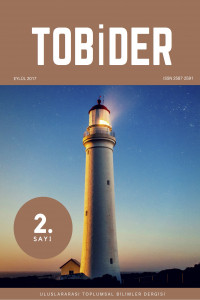Abstract
Sanat eseri tasarlayan öznenin, düşünce yapısı gündelik düşünme yapısından farklı gözükmektedir. Bu özel düşünme sisteminin yapısı incelendiğinde, bir sanat nesnesinin sanatçı tarafından nasıl ortaya konduğunu irdelemek gerekmektedir. Bu çerçevede Gottlieb Fichte’nin ‘ben’ üzerinden kurduğu ahlak ve özgürlük sistemi, sanat objesi tasarım sürecine uygulanabilirliği araştırılacaktır. Düşünür, kendi varlığını ortaya koyan bir ben, karşısında ben olmayan ve bölünebilir ben’e karşı mutlak ben’i koyarak bu bilişsel sürecin adeta nasıl eyleme dönüştüğünü açıklamıştır. Fichte, bu bilişsel süreci refleksiyon kavramı ile açıklar. Bilinç bir etkinliktir ve kendine geri dönen bir etkinliktir. Bu açıdan bakıldığında refleksiyon süreci öznenin nesne tasarımında etkili bir bilişsel süreçtir. Yine aynı şekilde sanatçı, sanat nesnesini izleyen, düşünüldüğünde sanat nesnesine karşı farklı refleksiyon süreçleri sonucu farklı değerlendirmeler elde edeceğimiz sonucuna varmak mümkün gözükmektedir.
Sanat objesi yaratım süreci imge, imge gücü, tasarım ve imgelem tüm bu düşüncel sistemin elemanlarıdır. İmgeden başlayarak tasarım sürecine giden bilişsel aktivitede sanat nesnesi de belirmeye başlar. Sanatçı kendi gerçeğin dışında kendi gerçekliğini eseri ile oluşturma yetisine sahiptir. Gerçeklik ve imge gücü iş birliği içindedir. Yeni gerçeklik, var olana yapılan ekleme-çıkarma ile oluşturulabilir. Bu bağlamda Hegel’in özne ve nesneye ilişkin bakışı bu konuya açıklık getirmektedir. Bilincin nesneye karşı ekleme çıkarma yaparak gerçekliği değiştirebileceğinden bahseder. Diğer yanda F. Schiller oyun oynayan insandan bahsetmektedir. İnsan zorunlu ve özgür tasarımlar arasında kalan bir varlıktır. Buna göre zorunlu olarak çevreden aldıklarını oyun oynayan insan olarak özgür tasarımlara dönüştürme yetisine sahiptir. Bu bağlamda gerek Hegel’in gerek Schiller’in de açıklamaları doğrultusunda Fichte’nin refleksiyon süreci daha iyi anlaşılabilir.
References
- Akarsu, B. (1988) Felsefe Terimleri Sözlüğü, İstanbul: İnkilap Kitapevi.
- Armaner, T. (1998) “Özne/Nesne İkiliği Açısından Sanatçı/Sanat Yapıtı İlişkisi: Kant, Fichte, Hegel, Heidegger”, Toplum ve Bilim, 79.
- Cevizci, A. (2009) Felsefe Tarihi, İstanbul: Say Yayınları.
- Copleston. (1990), Copleston Felsefe Tarihi Alman İdealizmi, çev. A. Yardımlı, İstanbul: İdea Yayınevi.
- Fichte, (2006), Alman İdealizmi 1 Fichte, Hazırlayanlar: E.A. Kılıçarslan, G. Ateşoğlu, Ankara: Doğu Batı Yayınları.
- Hegel (1986) Tinin Görüngübilimi, çev. A. Yardımlı, İstanbul: İdea Yayınevi.
- Ölçener, D. (2015) Öznel İdealizm Açısından Sanatta ve Sanat Felsefesinde Yaratıcılık, Yüksek Lisans Tezi, İstanbul: Maltepe Üniversitesi Sosyal Bilimler Enstitüsü.
- Spitzer, M., Maher, A. B. (1998), Felsefe ve Psikopatoloji, çev. Ö. Karaçan, İstanbul: Gendaş.
- Timuçin, A. (2004) Felsefe Sözlüğü, İstanbul: Bulut Yayınları.
- Tunalı, İ. (2012) Estetik, İstanbul: Remzi Kitabevi.
- Wittgenstein, L. (2007) Felsefi Soruşturmalar, çev. H. Barışcan, İstanbul: Metis.
Abstract
The subject of art object designers’ way of thinking seems to be different from Daily thinking. When this special thinking system is examined, it’s possible to analyze how an art object is created by its artist. In this regard, the ethics and liberty system created by Gottlieb Fichte over “I “; seems to be applicable in art object design process. The philosopher expressed how the cognitive process turns into act by putting “absolute I” against “not I” and “divisible I” against “I” who reveals its own existence. Fichte explains this cognitive process with reflection concept. Conciousness is an event which turns to itself. In this point of view, the reflection process is a cognitive process which is very effective on object design of subject. As we think in the same way, the artist and the people seeing the art object, can obtain different reflection process results against the art object.
The art object, the creation process, image, impression of image, representation and imagination are all elements / members / components of this thinking system. The art object also starts to become clear, on the way of cognitive act to the design process, starting from the image. The artist has the ability to create his own reality, out of his own real with his artwork. The reality and the impression of image are in cooperation. The new reality, can be created by adding-extracting to the existing. In this context, Hegel’s point of view on subject and object clarifies this topic. He mentions that the consciousness can change the reality, by making addition-extraction against the object.
On the other side, F.Schiller mentions about the man playing games (homoludens). The human is a being, stays between mandatory and free design. With regards to this, the human who plays the games has the ability to turn the mandatory receivables from the environment/media, to free design. In this context, Fichte’s reflection process could be understood better, in accordance with both Hegel and F.Schiller’s explanations.
Keywords
References
- Akarsu, B. (1988) Felsefe Terimleri Sözlüğü, İstanbul: İnkilap Kitapevi.
- Armaner, T. (1998) “Özne/Nesne İkiliği Açısından Sanatçı/Sanat Yapıtı İlişkisi: Kant, Fichte, Hegel, Heidegger”, Toplum ve Bilim, 79.
- Cevizci, A. (2009) Felsefe Tarihi, İstanbul: Say Yayınları.
- Copleston. (1990), Copleston Felsefe Tarihi Alman İdealizmi, çev. A. Yardımlı, İstanbul: İdea Yayınevi.
- Fichte, (2006), Alman İdealizmi 1 Fichte, Hazırlayanlar: E.A. Kılıçarslan, G. Ateşoğlu, Ankara: Doğu Batı Yayınları.
- Hegel (1986) Tinin Görüngübilimi, çev. A. Yardımlı, İstanbul: İdea Yayınevi.
- Ölçener, D. (2015) Öznel İdealizm Açısından Sanatta ve Sanat Felsefesinde Yaratıcılık, Yüksek Lisans Tezi, İstanbul: Maltepe Üniversitesi Sosyal Bilimler Enstitüsü.
- Spitzer, M., Maher, A. B. (1998), Felsefe ve Psikopatoloji, çev. Ö. Karaçan, İstanbul: Gendaş.
- Timuçin, A. (2004) Felsefe Sözlüğü, İstanbul: Bulut Yayınları.
- Tunalı, İ. (2012) Estetik, İstanbul: Remzi Kitabevi.
- Wittgenstein, L. (2007) Felsefi Soruşturmalar, çev. H. Barışcan, İstanbul: Metis.
Details
| Primary Language | Turkish |
|---|---|
| Journal Section | Uluslararası Toplumsal Bilimler Dergisi Cilt 1 Sayı 2 |
| Authors | |
| Publication Date | September 27, 2017 |
| Published in Issue | Year 2017 Volume: 1 Issue: 2 |


